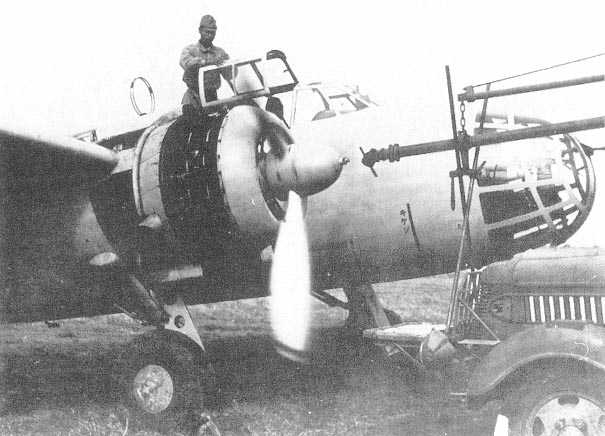
| Historical Information | |||||
| Caption | Ki-48 aircraft being serviced, circa 1940s ww2dbase | ||||
| Date | 1944 | ||||
| Photographer | Unknown | ||||
| Source Information | |||||
| Related Content | |||||
| More on... |
| ||||
| Licensing Information | |||||
| Licensing | This work originating in Japan is in the public domain. According to Article 23 of the 1899 Copyright Act of Japan and Article 2 of Supplemental Provisions of Copyright Act of 1970, a work is in the public domain if it was created or published before 1 Jan 1957. Please contact us regarding any inaccuracies with the above information. Thank you. |
||||
| Metadata | |||||
| Added By | C. Peter Chen | ||||
| Photo Size | 605 x 436 pixels | ||||
Please consider supporting us on Patreon. Even $1 per month will go a long way! Thank you. Please help us spread the word: Stay updated with WW2DB: |
Visitor Submitted Comments
2.  Bill says:
Bill says:
1 Apr 2011 08:13:02 PM
THE HUCKS STARTER:
This was an auxiliary power unit, that was built on truck chassis it was designed to start piston aircraft engines.
The power is transmitted to the aircraft by a power take-off shaft driven by a special chain from the gearbox to drive a layshaft mounted high and could be adjusted it looked alot like a drive train of a rear wheel drive vehicle. The starter truck looks like a Toyota GB light truck, during WWII Toyota produced light and heavy trucks, for the Japanese military.
ONE GOOD TURN:
The shaft of the starter fits into a special protruding hub in the center of the aircraft propeller the trucks engine transmits power to the shaft, which in turn spins starting the aircraft engine when the planes engine is running, the shaft is disengaged, the truck pulls away.
Designed in 1916 many air forces used this system and was in service through the 1920s, 1930s and early 1940s, and aircraft engines designed for this type of starting.
Both the the Imperial Japanese Army and Navy used this type of starting for most of its early and mid-war aircraft.
This device is named in honor of Captain Charles B. Hucks of the Royal Flying Corps, who devised it.
1 Apr 2011 08:13:02 PM
THE HUCKS STARTER:
This was an auxiliary power unit, that was built on truck chassis it was designed to start piston aircraft engines.
The power is transmitted to the aircraft by a power take-off shaft driven by a special chain from the gearbox to drive a layshaft mounted high and could be adjusted it looked alot like a drive train of a rear wheel drive vehicle. The starter truck looks like a Toyota GB light truck, during WWII Toyota produced light and heavy trucks, for the Japanese military.
ONE GOOD TURN:
The shaft of the starter fits into a special protruding hub in the center of the aircraft propeller the trucks engine transmits power to the shaft, which in turn spins starting the aircraft engine when the planes engine is running, the shaft is disengaged, the truck pulls away.
Designed in 1916 many air forces used this system and was in service through the 1920s, 1930s and early 1940s, and aircraft engines designed for this type of starting.
Both the the Imperial Japanese Army and Navy used this type of starting for most of its early and mid-war aircraft.
This device is named in honor of Captain Charles B. Hucks of the Royal Flying Corps, who devised it.
All visitor submitted comments are opinions of those making the submissions and do not reflect views of WW2DB.
Change View
Desktop ViewSearch WW2DB

News
- » US State Lawmaker John Winter Caught Using Racial Slur "Jap" and Apologized (11 Jun 2025)
- » Köln/Cologne Evacuated After Discovery of WW2 Bombs (4 Jun 2025)
- » US Women's Army Corps "Six Triple Eight" Awarded with Congressional Gold Medal (30 Apr 2025)
- » Race, Holocaust, and African-American WW2 Histories Removed from the US Naval Academy Library (7 Apr 2025)
- » US Government Plans to Purge WW2 Information (17 Mar 2025)
- » See all news
Current Site Statistics
- » 1,175 biographies
- » 337 events
- » 44,927 timeline entries
- » 1,245 ships
- » 350 aircraft models
- » 207 vehicle models
- » 376 weapon models
- » 123 historical documents
- » 261 facilities
- » 470 book reviews
- » 28,466 photos
- » 365 maps
Famous WW2 Quote
"Among the men who fought on Iwo Jima, uncommon valor was a common virtue."Fleet Admiral Chester W. Nimitz, 16 Mar 1945
25 Mar 2011 10:09:45 PM
Engine startup the Japanese used starter trucks with a power takeoff, was taken from the gearbox it rose behind the truck cab and projected forward, this was mated to the aircrafts spinner to start the engine, chocks were used to secure the wheels